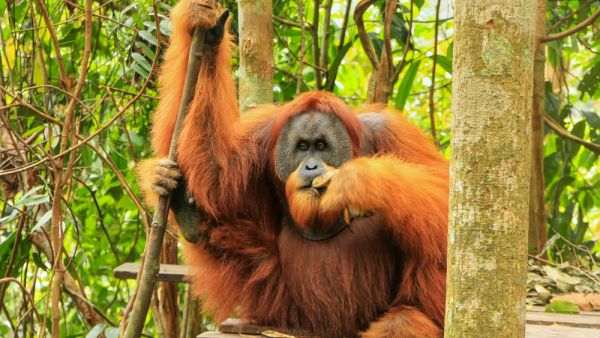Orangutans have figured out how to make hooked tools out of straight wire, in an ‘astonishing’ behaviour that experts say appeared late in our own evolutionary timeline.
Researchers have observed this type of tool-making in orangutans for the first time, showing how the great apes quickly manufactured an instrument of the appropriate shape to reach their treat at the bottom of a vertical tube.
Human children, on the other hand, have a much more difficult time with this task; in prior experiments, kids aged 3 to 5 years old rarely succeeded, while only about half of 7-year-olds were successful in their attempts.
The new study was led by a team of cognitive biologists and comparative psychologists from the University of Vienna, the University of St. Andrews, and the University of Veterinary Medicine in Vienna.
‘We confronted the orangutans with a vertical tube containing a reward basket with a handle and a straight piece of wire,’ said Isabelle Laumer, who conducted the study at the Zoo Leipzig in Germany.
‘In a second task with a horizontal tube containing a reward at its center and a piece of wire that was bent at 90 degrees.
‘Retrieving the reward from the vertical tube thus required the orangutans to bend a hook into the wire to fish the basket out of the tube.
‘The horizontal tube in turn required the apes to unbend the bent piece of wire in order to make it long enough to push the food out of the tube.’
The researchers discovered that the orangutans were quick to figure out what they needed to do to complete the task.
Two of the apes even solved both the bending and unbending tasks within the first few minutes.
According to the experts, orangutans appear to outperform human children in doing this. Previous research showed that kids typically don’t figure out how to make hook tools when necessary until the age of 8.
Orangutans, however, were able to do this with surprising precision.
‘The orangutans mostly bent the hooks directly with their teeth and their mouths, while keeping the rest of the tool straight,’ Laumer said.
‘Thereafter, they immediately inserted it in the correct orientation, hooked the handle and pulled the basket up.’
While orangutans are well-known to be intelligent, and share 97 percent of their DNA with humans, researchers still say the latest discovery comes as a shock.
The study suggests the apes are not simply applying routinized behaviors, but instead are actively inventing a solution to the problem before them, said Alice Auersperg from the University of Veterinary Medicine.
‘Finding this capacity in one of our closest relatives is astonishing,’ added Josep Call of the University of St Andrews.
‘In human evolution, hook tools appear relatively late. Fish hooks and harpoon-like, curved objects date back only approximately 16,000 to 60,000 years.
‘Although New Caledonian crows use hooks with regularity, there are a few observations of wild apes, such as chimpanzees and orangutans, that use previously detached branches to catch and retrieve out-of-reach branches for locomotion in the canopy.
‘Such branch-hauling tools might represent one of the earliest and simplest raking tools used and made by great apes and our ancestors.’
This article has been adapted from its original source.








